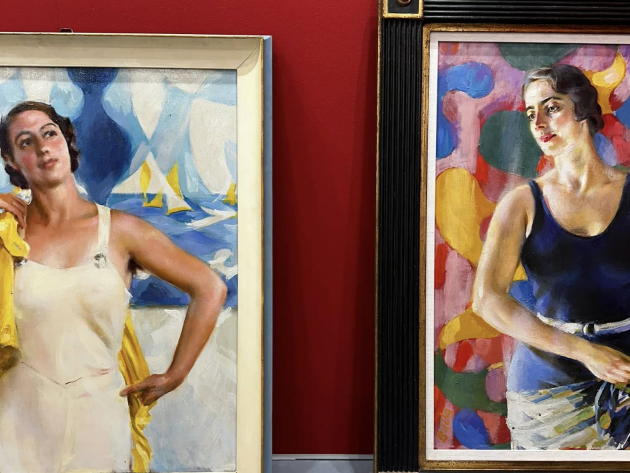
The Russo Gallery, near Piazza di Spagna, hosts the exhibition Nymph and Muse. A century of the feminine in art, dedicated to the different interpretations of the female figure in some great masters of the nineteenth and twentieth centuries. The exhibition, curated by art historian Daniela Fonti, presents a selection of 55 works - including drawings, paintings and sculptures - in which the relationship between art and the female figure mainly emerges, seen as the protagonist of a new social and cultural scene.
The exhibition therefore offers a fascinating overview through Italian art from the 19th to the 20th century, where the great Italian artistic currents are the protagonists: from the Macchiaioli to Futurism, from the Roman School to the 20th century, up to the threshold of the Second World War, with the representation of women in the visual arts and their evolution in the latter at its centre.
The exhibition opens with John Singer Sargent and his Princess de Beaumont painted in 1884 and Antonio Mancini, with Female Figure (1890-1900), in which the artist investigates the intimacy and psychology of the woman depicted, capturing her beauty in a suspended moment. The exhibition continues with Amedeo Modigliani's Caryatid, which is part of a cycle created between 1910 and 1914, where classical research is intertwined with a contemporary sensitivity. Alongside this we find the Portrait of a Little Girl (1911) by Umberto Boccioni which, with its chromatism, dynamism and attention to the psychology of the subject, anticipates the innovations of Futurism. With the two studies entitled The Mad woman (1904) Giacomo Balla explores unusual aspects of madness, drawing details of the clothing or the unstable and disjointed posture of the young woman portrayed, while with The Daughter of the Sun (1933) making reference to the popular techniques of photography and cinema, he gives us the representation of women in a contemporary sense. Another masterpiece on display is Bathers on a Beach (1934) by Giorgio de Chirico, in which, in an almost dreamlike dimension, female figures inspired by those of Titian and Ingres are represented, in a context between metaphysical reality and everyday reality. The Sleeping Woman (1933) and the Two Nudes (1947-1948) by Carlo Levi, on the other hand, are works in which the color gives shape and fullness to the figures with brushstrokes that bring out their sensuality, while the two tempera paintings by Gino Severini Danseuse dans la lumière (étude de mouvement) (1913) and Danseuse abstraite (1958), characterized by a futurist language and neocubist, highlight the centrality of the theme of dance in his artistic research.
Even the language of art nouveau, which developed between 1889 and 1913 and in which the female model is expressed in an innovative way, is well represented in the exhibition by the works of Duilio Cambellotti, one of its important exponents in Italy. His research, aimed at European models, is realized in graphic projects, advertising billboards and designs for stained glass windows that create a new aesthetic for the bourgeois homes of the new unitary state.
Part of the exhibition are also the masterpieces of Henri Matisse who, with Nu debout (1908-1909), makes the female nude, with its unmistakable features, the centre of his artistic teaching during the courses held at the International Academy of Paris, outlining forms that make the woman's body an expression of purity and freedom. The synthetic form was also analyzed by Adolfo Wildt with the work Crying on the Closed Door from 1919, a drawing with a fine technique, which the artist donated to the critic and writer Margherita Sarfatti, his great supporter. The latter is the protagonist of Mario Sironi's work from 1916-1917: a particular pastel and tempera in which the artist manages to capture the psychological nature of the subject, highlighting the importance of its role in the cultural and social panorama of the period. These different and varied ways of representing female figures can be found in the works of André Derain, Achille Funi, Antonio Donghi, Carlo Socrate, Scipione, Carlo Levi, Fausto Pirandello on display in the Gallery. Research on the nude was also developed by Felice Casorati with Back Nude (1921-1922) and by Arturo Martini with the sculpture The Pisan Woman (1928-1930), two images of abstract purity alluding to an Eden considered lost. Also important are the sculptures by Giacomo Manzù present in the exhibition: Head of Inge (1947) and Seated Model (1959), together with the surreal Dancer (1956) by Mirko Balsaldella. At the end of the exhibition itinerary is the dreamlike and original testimony of Alberto Savinio, whose Birth of Venus (1950) is exhibited, a work that proposes a particular vision of woman as a hybrid generated by the encounter between the animal world and the mythological world.
The exhibition, therefore, in which portraits, scenes of domestic life, symbolist and metaphysical representations, give us the female figure in its many facets, reveals how art has narrated the changes in the female condition: from the most traditional roles, up to the emergence of a new awareness, between social expectations, personal desires and modern tensions.
Photo credits: official Facebook page of the Russo Gallery
Informationen
Da venerdì 21 febbraio a giovedì 13 marzo 2025
Da martedì a sabato dalle ore 10.00 alle ore 19.30
Il lunedì dalle ore 16.30 alle ore 19.30
 Condividi
Condividi











































